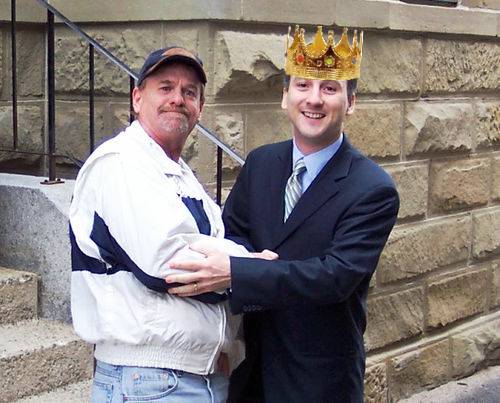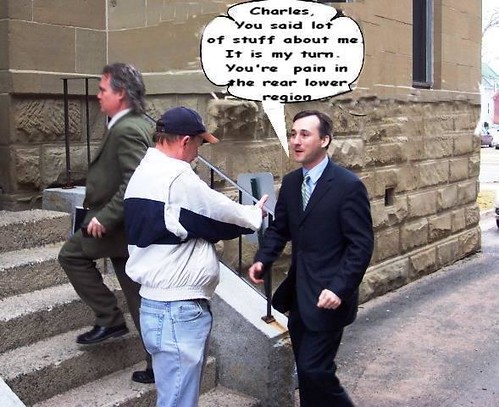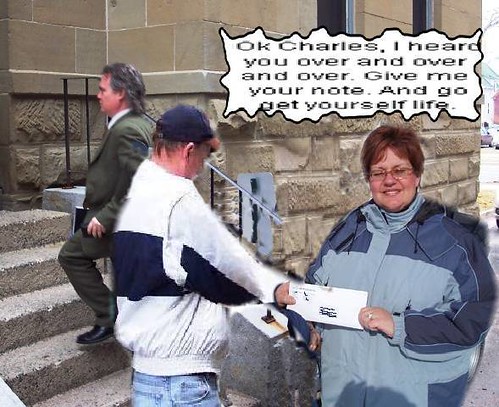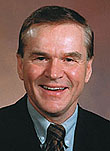Evelyn Pringle: ADHD Drugs - Cash Cow For Pharma
Wednesday, 15 February 2006, 11:21 am
Opinion: Evelyn Pringle
ADHD Drugs - Cash Cow For Pharma
By Evelyn Pringle
February 13, 2006
lawyersandsettlements.com“Our society viewed with loathing those who 'pushed' stimulant drugs on children," says child psychiatrist Dr Peter Breggin. "Yet today, there are more children taking Ritalin and amphetamines from doctors than ever received them from illegal pushers,” he says.
“Parents and teachers and even doctors have been badly misled by drug company marketing practices,” he warns. “Drug companies have targeted children as a big market likely to boost profits and children are suffering as a result."
The marketing campaign referred to by Dr Breggin has proven to be extremely successful At a February 10, 2006, FDA advisory committee hearing, it was reported by Dr Andrew Mosholder, a medical officer in the FDA's Office of Drug Safety, that about 2.5 million children in this country between the age 4 and 17, currently take ADHD drugs. A government survey found 9.3% of 12-year-old boys, and 3.7% of 11-year-old girls are on the drugs, he said.
In 1980, the so-called Attention Deficit Disorder (ADD), which amounts to little more than a list of behaviors, was voted into existence as a mental illness by the American Psychiatric Association, so it could be included in the psychiatric billing Bible known as the Diagnostic & Statistical Manual for Mental Disorders, DSM.
In 1987, an H was added to the label and the illness became, "Attention Deficit Hyperactivity Disorder." Within one year, 500,000 children in the US were diagnosed with this cash-cow disorder.
A few years later, it was classified as a disability and a cash incentive program was initiated for low-income families with children diagnosed with ADHD. A family could get $450 a month for each child diagnosed with the disorder, and the cost of treatment and medication for low-income children would be covered by Medicaid.
ADVERTISEMENT
Then in 1991, schools began receiving educational grants of $400 annually for each ADHD child. The same year, the US Department of Education classified the disorder as a handicap, which required special services to be provided to each disabled child.
By 1996, close to $15 billion was spent annually on the diagnosis, treatment, and study of the so-called attention deficit disorder.
Over roughly the past 2 years, public health officials in the US, Canada and the UK have issued warnings about previously known, but undisclosed, risks associated with the stimulant drugs used to treat ADHD.
In September 2005, Canadian public health officials asked drug makers to turn over data from all clinical trials and post-marketing reports for the medications by the end of 2005 to be reviewed in 2006.
The February 2006 hearings, represent the third time in 2 years that the FDA has addressed the heart related side effects of ADHD drugs. This whole charade is beginning to look more and more like a repeat of the Vioxx debacle.
Foot-dragging earned the FDA a rebuke this month from Senator, Chuck Grassley (R-Iowa), chairman of the Senate Committee on Finance, which has exclusive jurisdiction over the Medicare and Medicaid programs which, according to Sen Grassley, pay hundreds of millions of dollars for prescription drugs each year, including drugs used to treat ADHD.
In a February 6, 2006, letter to acting FDA commissioner, Dr Andrew von Eschenbach, Sen Grassley said in part, "I remain concerned that while both psychiatric and cardiovascular risk signals have cropped up across this class of drugs this past year, it appears that FDA is just now beginning to 'discuss approaches' for studying these risks."
“More specifically," Sen Grassley wrote, "I question why it has taken nearly an entire year for FDA to begin to address these concerns given the serious nature of the adverse events associated with these drugs.”
In the letter, Sen Grassley noted that the FDA had recently announced upcoming meetings of two different advisory committees to examine different ways of studying adverse events related to ADHD drugs when studies showing the risks had already been done. He accused the FDA of taking a slow approach to regulating the drugs.
As examples of risk already established, Sen Grassley pointed out that in February 2005, cardiovascular concerns raised in adverse event reports led Canadian health officials to suspend market authorization of Adderall XR for six months due to a review of safety information from Shire that showed 20 international reports of sudden death and that in 2004, the FDA required Shire to include the risk of sudden death on the label.
He noted that last summer, the safety of the drugs was called into question when the FDA publicly stated that it had concerns about psychiatric side effects from the use of Concerta and specifically stated on its website that it had “identified two possible safety concerns with the methylphenidate drug products: psychiatric adverse events and cardiovascular adverse events.”
Sen Grassley also pointed out that in September of 2005, the FDA had issued an alert to healthcare professionals regarding the use of Strattera, after reviewing data showing an increase in suicidal thoughts in 12 separate studies, and directed Eli Lilly, to “revise the labeling…to include a boxed warning and additional warning statements regarding an increased risk of suicidal thinking in children and adolescents.”
As an added pressure, Sen Grassley asked for a complete list of names of participating panel members and a complete list of conflict disclosures for both the February 9-10 2006, advisory committee and the March 22, 2006, Pediatric Advisory Committee.
The latest report made public by the FDA at the February 2006 hearings, said that between 1999 and 2003, there were twenty-five deaths in persons using ADHD drugs, including the deaths of 19 children. Officials also admitted to receiving reports of more than 50 cases of cardiovascular problems, including stoke, heart attack, hypertension, palpitations and arrhythmia.
The report only covers a 4 year period and because only between 1 and 10% of adverse events are ever reported, the numbers above represent a gross understatement of actual cases of harm from these drugs.
The report could not have considered the increase in emergency room visits associated to Ritalin abuse alone over the past decade. According to the Drug Abuse Warning Network, while there were 271 Ritalin-related emergency room visits in 1990, there were 1,478 Ritalin-related visits in 2001.
According to the National Institute of Drug Abuse, in 1999, some 165 Ritalin-related poison calls were made in Detroit; 419 cases were reported in Texas, and only 114 of those cases involved intentional misuse or abuse.
While the FDA foot-dragging has continued for years, the drug companies have been making a fortune by pushing the exact same pills that have been pedaled on the street for 50 years under names like black beauties, yellow jackets, uppers, white crosses, and bennies.
These are the exact same drugs that were handed out like candy in the 1960s and 1970s, when prescribed under the guise of diet pills, and used by truckers to stay awake, by entertainers and athletes to perform, and by people who wanted to party for days in the general population, until they were banned.
The drugs contain the exact same amphetamine that was THE main ingredient in the once popular "B-12" injections given weekly to wealthy patients in doctor's offices all over the country until they were banned.
So here we are in 2006, with pharma making a killing by selling dangerous drugs that have been outlawed time and time again. What kind of profits are we looking at? As of September 2005, Walgreen's prices for a 30 day supply for the lowest dosage of the top selling drugs were:
• Methylphenidate (generic Ritalin) $15.69
• Ritalin (brand name): $27.79
• Amphetamine/dextroamphetamine (generic Adderall): $47.09
• Adderall (brand name): $94.49
• Concerta: $103.99
• Strattera: $123.99
According to Dr Mosholder, since March 2002, prescriptions written for adults rose by 90%, to about 1 million a month as of June 2005, and to about 2 million a month for children.
If the three million people are on the lowest priced Ritalin, a round number of $30 per month times 3 million would create over $1 billion a year for the drug company alone. Then add in the medical and psychological professional fees and the grand total easily exceeds $2 billion per year. And if the patients are on Adderall, the cost of the drug triples to over $3 billion a year.
The money earned by prescribing shrinks is nothing to sneeze at either. A 2003 American Psychological Association study on "financial disincentives" for psychotherapy found that doctors could earn about $263 an hour for doing three 15-minute "medication management" sessions, verses about $156 for a single 45 to 50-minute therapy session. That represents a pay cut of 41% an hour for doing therapy only, the study determined.
However, hopefully we are about to see a dwindling of the above profit margins.
On February 10, 2006, the Drug Safety and Risk Management advisory committee said that ADHD drugs should carry the strongest warning label that they may be linked to an increased risk of death and injury.
One of the committee members who pushed for the label, Cardiologist, Steven Nissen, said something must be done to curtail the prescription rates. "I feel strongly we need to slow the growth of utilization," he said. "When you have that kind of exposure for drugs that are suspicious, that does create a major public health concern," he added.
This legally prescribed speed is being passed around between students in schools and colleges all over the nation. A 2002 study by the University of Wisconsin estimated that one of five college students takes Adderall, many for recreational reasons.
On July 25, 2005, CBS News reported that "Adderall and Ritalin have in fact become "street drugs" at America’s colleges and universities, where prescription stimulants often replace coffee and CliffsNotes as the study aids for today’s college students."
According to Dr Sean Esteban McCabe, interim director of the University of Michigan Substance Abuse Research Center, a recent survey found that 6.9% of American college students have taken prescription stimulants illicitly, and up to 25% at certain elite universities with high academic pressures and admission standards.
The study canvassed students at 119 four-year colleges and universities nationwide and was published in the January 2005 issue of the journal Addiction. The specific focus of the study was the non-medical use of Ritalin, Dexedrine and Adderall.
Based on his survey, Dr McCabe found that, prescription stimulant abuse tends to lead to higher rates of other drug abuse and driving while drinking.
The survey found that students who had used a prescription stimulant non-medically in the past year were 10 times more likely to report the use of marijuana, twenty times more likely to use cocaine, and 5 times more likely to report driving after binge drinking.
On December 5, 2005, the Nashville, Tennessee based newspaper, The Tennessean reported that Athletes aren't the only ones popping pills to gain a competitive edge these days.
"College students are turning to prescription stimulants such as Adderall and Ritalin to get them through late-night cram sessions, risking potential side effects and unknown long-term effects for a chance at a better grade," it wrote.
"I would say it's pretty common," says Matthew Fleischer, a senior philosophy major at Vanderbilt University. "I know people who use it; I know people who call me and ask me if I can find some for them," he told the Tennessean.
More than 50 college newspapers have already published articles describing Adderall abuse on campus according to CBS News.
For school age children, these drugs are providing a spring-board into early addiction. Over the past few years, high school students have been busted for using the legal speed all across the country.
For instance, on March 16, 2001, in Norwich Connecticut, 3 eighth-graders were hospitalized when they overdosed on Adderall at school.
On September 12, 2002, NBC TV News reported that 11 students were transported to Antelope Valley and Lancaster Community Hospital in Los Angeles California, for treatment of possible overdose from Ritalin. The school confiscated a large amount of Ritalin pills. "I would say in excess of 150," said school principal Mark Bryant.
In three separate cases in 2004, Tucson, Arizona area students were caught with Adderall. Six Catalina Foothills High School students were suspended for taking or possessing Adderall while on campus, according to reports from the Pima County Sheriff's Department reports.
Two Ironwood Ridge High School students, ages 15 and 17, were cited for exchanging Adderall in January, 2004, according to an Oro Valley, Arizona police report.
And 6 football players at Millennium High School in Goodyear, Arizona were disciplined by the Agua Fria Union High School District for taking Adderall before a game.
In both of the Tucson cases, students who had legal prescriptions for Adderall and brought the pills to school and gave them to classmates.
On October 13, 2005, a 17-year-old Waukesha, Wisconsin boy was arrested on felony charges for possession of Adderall, after the car he was riding in was stopped for a broken taillight.
On January 20, 2006, Florida Okaloosa County Sheriff Department received word that a student at Richbourg Middle School had illegally shared the prescription drug Adderall.
"Unfortunately and sadly," Sheriff Rick Hord told reporters, "the news value may not be how unusual this is but rather how common it is."
"We've had 22 cases so far that have been investigated primarily by the resource officers but in a couple of incidents by other deputies, of drugs on campus at just about every school you can name," he said.
On February 7, 2006, two Harrington, Delaware middle school students were arrested for distributing Adderall at WT Chimpan Middle School over a period of 3 months. Both students were expelled.
If children are having problems, they need therapy not speed.
William Pelham, a well-known researcher involved with clinical trials of both Concerta and Adderall, says a major study, sponsored by the National Institute of Mental Health, showed that behavioral therapy often eliminates the need for drugs altogether.
During a one-year trial, he told The Street.com, 75% of the children who relied on behavioral treatments functioned well without the drugs. Moreover, he added, most of those children remained off the drugs a full year later.
"What this means to me is that two-thirds of ADHD kids could be taken off the medications," Pelham told Street.com. "I do think they are grossly overused as a first line of intervention," he added.
According to Dr Peter Breggin: "We are encouraging a generation of youngsters to grow up relying on psychiatric drugs rather than on themselves and other human resources."
"In the long run," he warns, "we are giving our children a very bad lesson, that drugs are the answer to emotional problems."

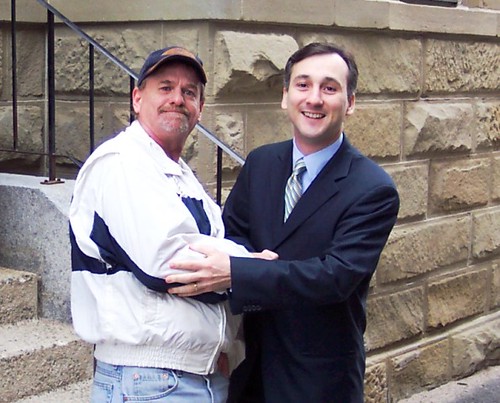





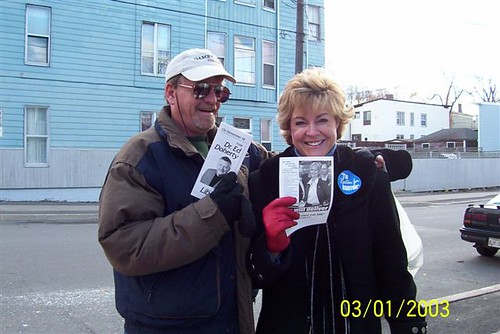





![hunt-squirt.[1]](http://static.flickr.com/33/50054542_a952c8139c.jpg)






